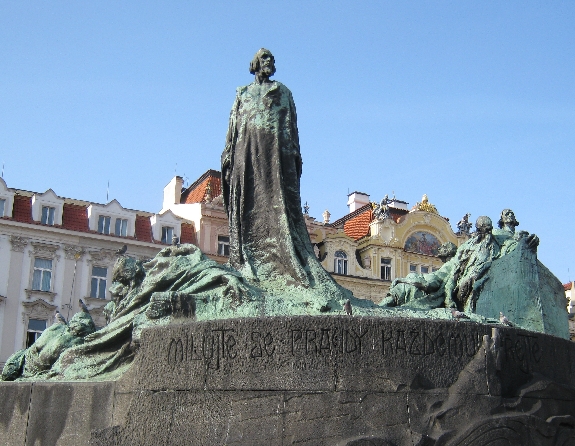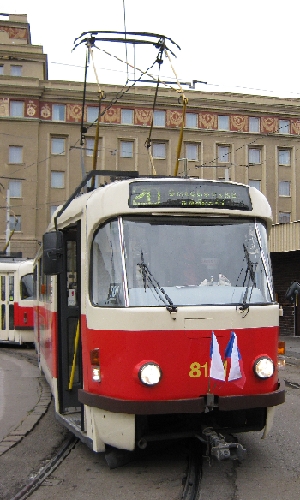
Three holy men from many centuries past, St. Cyril, St. Methodius and Jan Hus, are responsible for currently giving most Czech people a four-day long weekend. For yesterday, Thursday 5th July, is celebrated as Cyril and Methodius Day whilst today, Friday 6th July, marks the 597th anniversary of the burning at the stake in Konstanz, of the Father of the Czech Reformation, Jan Hus. And both days are kept as public holidays here in the Czech Republic.
I find it quite ironic that in this rather irreligious country, there are these two public holidays that celebrate the lives of three great Christians. However, the vast majority of Czech people just take advantage of having four days off work and head out to the Chata or Chalupa – the little (usually wooden) holiday cottages in the countryside that so many either own or have access to. In fact many people also take an additional three days leave with a number of offices and small shops around where we live being closed for the whole week.
So why does the Czech Republic honour these three great Christian men? Because of their contribution to the development of Czech culture far more than their contribution to the proclamation and later reformation of the Christian faith in this land.
St. Cyril and St. Methodius, who were brothers from Thessaloniki, are celebrated by the Christian Church, as 9th century missionaries to the Slavs. But as part of their missionary endeavour, they created an alphabet which allowed the language of the Slavic people to written down for the first time. This enabled the scriptures to be translated and the creation of a liturgy in the language of the people.
The Glagolitic alphabet that Cyril and Methodius devised, was the precursor to the Cyrillic alphabet in which many Slavic languages are presently written – though fortunately not Czech 🙂 This written form of the language is now known as Old Church Slavonic. Whilst it is a language that is no longer regularly spoken, it is still used in liturgy by some Orthodox Churches.
The Czech National Revival of the nineteenth and early twentieth centuries, which led to the establishment of a newly independent Czechoslovakia in 1918, was very much based around the recovery and use of the Czech language, in opposition to the Germanisation of government, education and culture in Bohemia and Moravia under the auspices of the Austro-Hungarian Empire. Therefore St. Cyril and St. Methodius are honoured because they were responsible for the written origins of the Czech language, even though thankfully, it now uses the Latin rather than the Cyrillic alphabet!

Jan Hus, about whom I wrote a long illustrated post back in April 2011 entitled Jan Hus – Leader of the Bohemian Reformation and Czech Hero, led what is known as the Bohemian Reformation. As I wrote in that earlier post, ‘he was very much influenced by the teaching and writings of the early English Church Reformer John Wycliffe, and in his preaching, called for reform within the Roman Catholic Church. He was particularly outraged by the selling of papal indulgences to collect funds for military purposes’.
However, there are two significant things which Hus did or advocated which are reflected in the way he is now remembered by most Czech people. Firstly, he preached and wrote in Czech rather than Latin as he wanted his hearers and readers to fully understand what he was saying. Secondly, he wanted worshippers to be able to receive communion in both kinds – both bread and wine – and for lay people not to be forbidden to receive the chalice’
It is his insistence on the use of the Czech language that causes Jan Hus to be celebrated today as a cultural hero. He was also responsible for the introduction of diacritics into Czech spelling in order to represent each sound by a single symbol. His opposition to Church control by the Vatican is also seen in terms of defending the Czech people from outside powers.
As I wrote at the outset of this post, today marks the 597th anniversary of Jan Hus being burnt at the stake having been found guilty of heresy by the Council of Konstanz. Nearly 600 years on, this continues to cause problems for the Czech Roman Catholic Church. For nearly all Czech people regard Jan Hus as a national hero yet it was the Roman Catholic Church who most unjustly condemned him and had him put to death.
To his credit, during a visit to Prague in 1999, Pope John Paul II did issue an apology for ‘the cruel death inflicted upon Jan Hus’ and for the ‘consequent wound of conflict and division which was thus imposed on the minds and hearts of the Bohemian people’. But there was still no admission that the Council of Konstanz actually got it wrong. It is going to be very interesting to see how the Roman Catholic Church responds to plans beginning to be made to mark the 600 anniversary of the death of Jan Hus in exactly three years time.
In the meantime, I will be remembering the life, teaching and example of each of these three great men of faith as part of our worship this coming Sunday, in Prague in the morning and in Brno in the evening, including using these two collects.
Lord of all, who gave to your servants Cyril and Methodius the gift of tongues to proclaim the gospel to the Slavs: make your whole Church one as you are one that all Christians may honour one another, and east and west acknowledge one Lord, one faith, one baptism, and you, the God and Father of all; through Jesus Christ your Son our Lord, who is alive and reigns with you, in the unity of the Holy Spirit, one God, now and for ever. Amen
Almighty God, who gave to your servant Jan Hus boldness to confess the Name of our Saviour Jesus Christ before the rulers of this world, and courage to die for this faith: Grant that we may always be ready to give a reason for the hope that is in us, and to suffer gladly for the sake of our Lord Jesus Christ; who lives and reigns with you and the Holy Spirit, one God, for ever and ever. Amen


 Knowing the dates of public holidays when you move to or visit a country of which you are not a native, is quite important as my wife and I found out only on Monday of this past week. We were returning from our trip to Turkey about which I’ve just started blogging, when we drove from Italy into Austria on the penultimate leg of our journey home to Prague. We were driving along the Austrian autobahn when my wife said, “Rather than stop at a service station for lunch, why don’t we drive into a nearby town and find a nice restaurant instead?”
Knowing the dates of public holidays when you move to or visit a country of which you are not a native, is quite important as my wife and I found out only on Monday of this past week. We were returning from our trip to Turkey about which I’ve just started blogging, when we drove from Italy into Austria on the penultimate leg of our journey home to Prague. We were driving along the Austrian autobahn when my wife said, “Rather than stop at a service station for lunch, why don’t we drive into a nearby town and find a nice restaurant instead?”